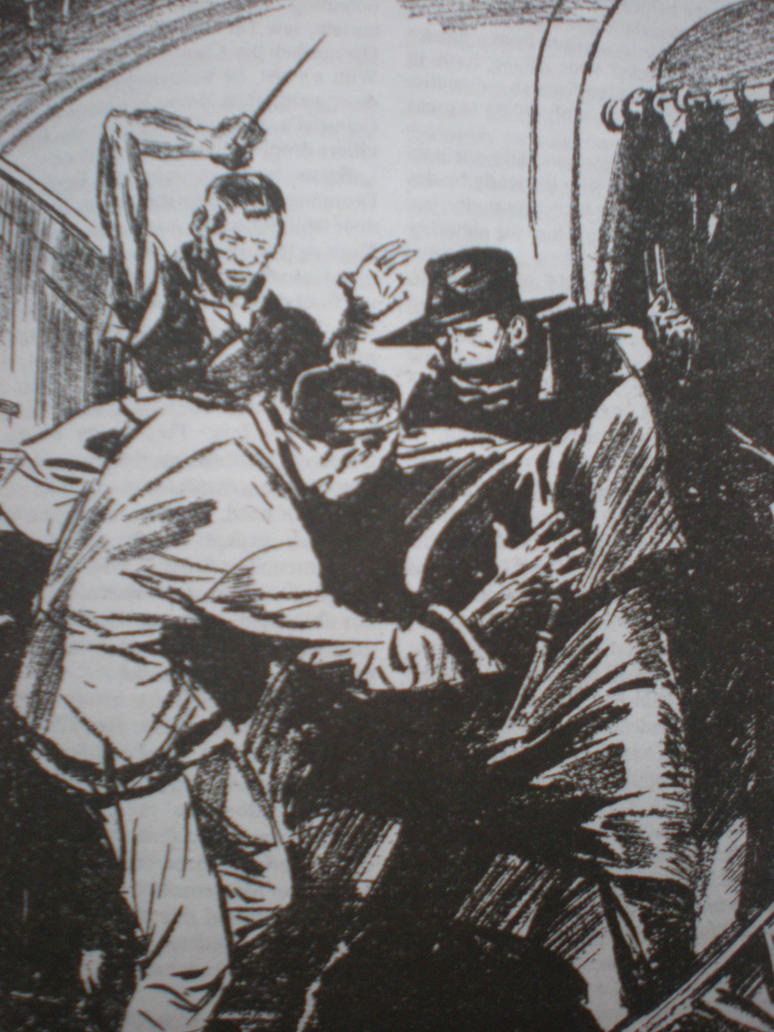Well, you know us here at Bad Girls, Good Guys, and Two-Fisted Action... when we have a question or two burning in our craniums, we scope out the usual suspects and ask 'em.
Which do you prefer as a reader -- illustrated pulp stories or those without illustrations?
 |
| Art by The Savage Scribe |
Bill Cunningham: Sometimes the illustrations add to the story, but often I find they conflict with my own mental image of the characters. On the other hand not having illustration leaves room for more story...
M.D. Jackson: For me the illustrations are part of the magic of the whole pulp experience. When I collect old original pulp magazines they have to be illustrated. It doesn't even matter if the illustration is any good, just being illustrated is part of its charm. I love the whole experience of the old pulp magazines and the illustrations are, for me about 50 percent of the equation.
Lee Houston, Jr.: In all honesty, I think it depends upon the genre. I can see having art in almost everything except science-fiction. That would the one genre where I would prefer to have the images left to my imagination.
Ed Erdelac: This may go back to when I was a kid and couldn't read. I would conjure stories around the illustrations. I really enjoy the plates in the old pulps - even the later collections with Frazetta art. They're a surprise to look forward to as you read along.
What are the advantages of having illustrations in a pulp novel or collection?
 |
| Art Basil Wolverton |
M.D. Jackson: As an illustrator myself I am naturally biased in that direction. Illustrating is what I do, it's how I ply my trade and when I was publishing Dark Worlds Magazine illustrations were a key part of the whole package. Having illustrations, particularly ones done in the traditional "pulp" style helped to identify us with the pulp magazines. One look at a printed edition ad there was no doubt about what you were going to get.
Lee Houston, Jr.: You certainly have an idea of what is going on and what the characters look like. This definitely works best for me in swashbuckling tales and mysteries, so you can keep better track of the suspects and situations and ponder along with the detective on duty to figure out just who did what and how, let alone why.
Ed Erdelac: I still like the illustrated versions, especially the reprints of The Shadow complete with ads. It recreates the whole experience, I think.
What are the advantages of not having art inside the pulp novel or collection?
 |
| Art by Virbil Finlay |
M.D. Jackson: The main disadvantage was reproducing that experience in electronic editions. Formatting an illustrated publication for Kindle or other e-reader add s an extra level of pain and suffering to what is already a major annoyance. Some of our electronic editions had to eliminate the illustrations completely. While it is true that if a story is good it should be able to stand on its own, when I am craving the pulp experience, I want the story to be enhanced by those illustrations.
Lee Houston, Jr.: Sometimes the artist interpretations don't match your imagination, which is why I prefer fewer in science fiction. But with all that said, if illustrations originally accompanied a tale, I prefer to have them reprinted with the story to get the full feel of both the tale and the period it was originally produced in. The difference is noticeable when comparing such things like the Shadow paperback reprints of the 1970s to the Nostalgia Ventures' reprints of today.
Ed Erdelac: Well, when you read you picture the characters and situations in your mind. You take the words the author uses as a jumping off point, extrapolating their appearance from your own unique experiences and perspectives. That's why the movie is almost never as good as the book to most people. A filmmaker can never make the movie that's in everyone's mind's eye. So when you include illustrations in a book there's a chance of not gelling with the reader's concept of your story. Less than stellar art can be a turn off too.
===================================================================
For more information: John F. Allen | Ed Erdelac | Lee Houston, Jr. | M.D. Jackson | Bill Cunningham


At 48 years old I find myself reading independent comics more and more and less prose. So I guess I like pulp with illustrations.
ReplyDeleteI used to try reading equal amounts of both, but I find myself reading more comics, mainstream and indie, nowadays. Partly because I work in a comic book store.
ReplyDeleteEvery now and then, be it in pulp, new pulp, classical or mainstream literature, a near definitive set of illustrations turns up for certain stories. They tend to become almost iconic for the majority of readers, and I like to believe this is because they are the ones most atuned to the writer's imagination.
ReplyDelete